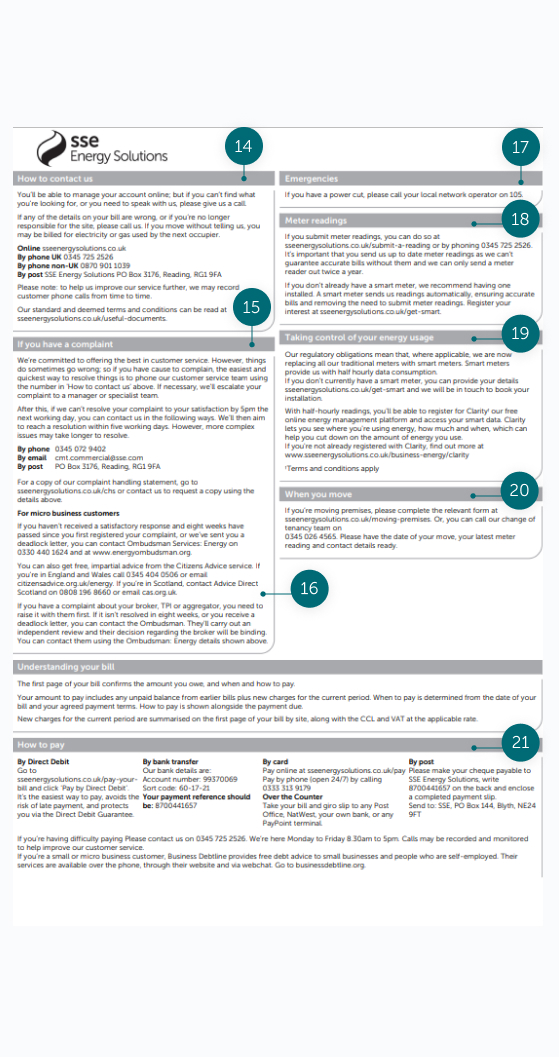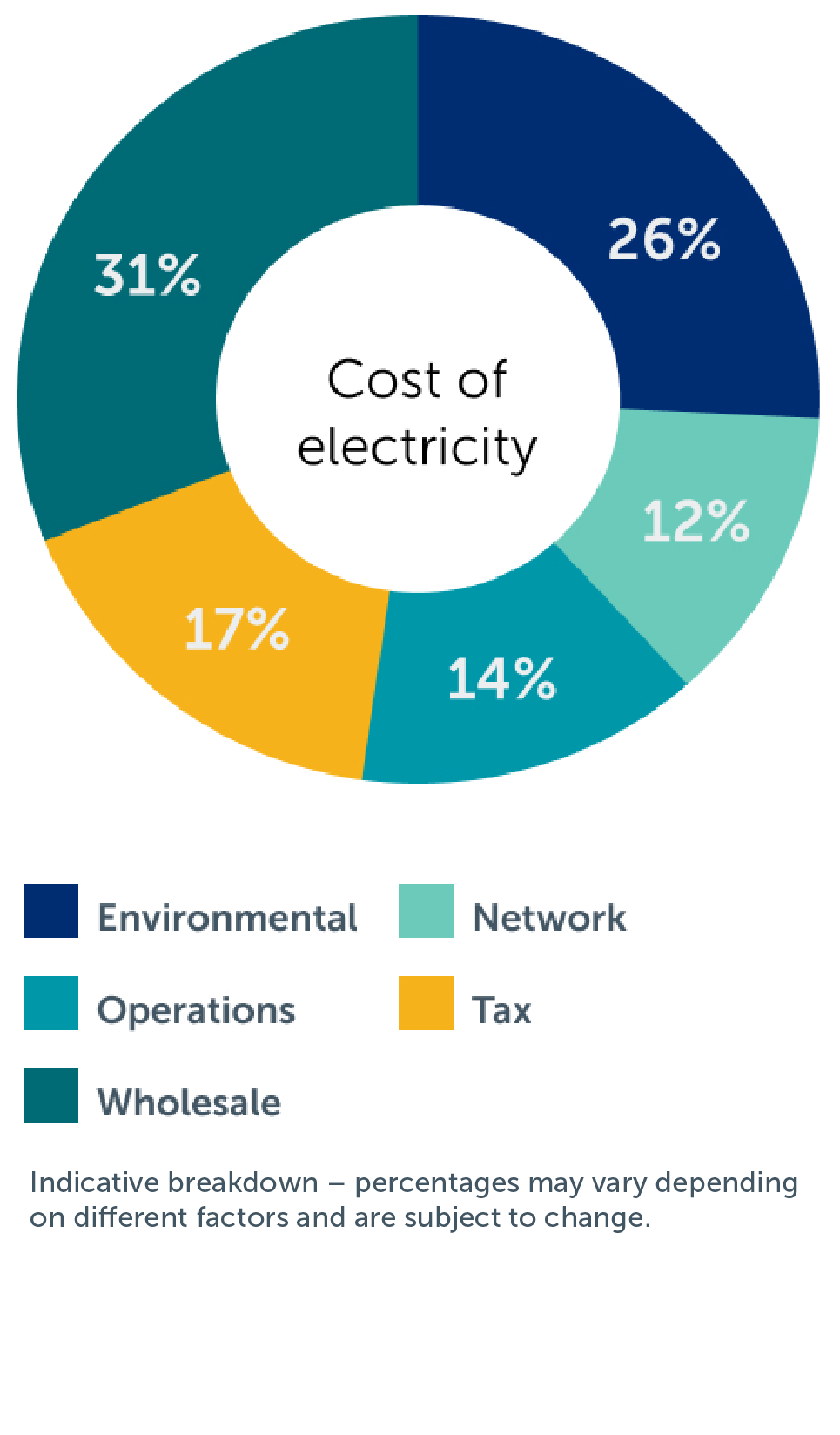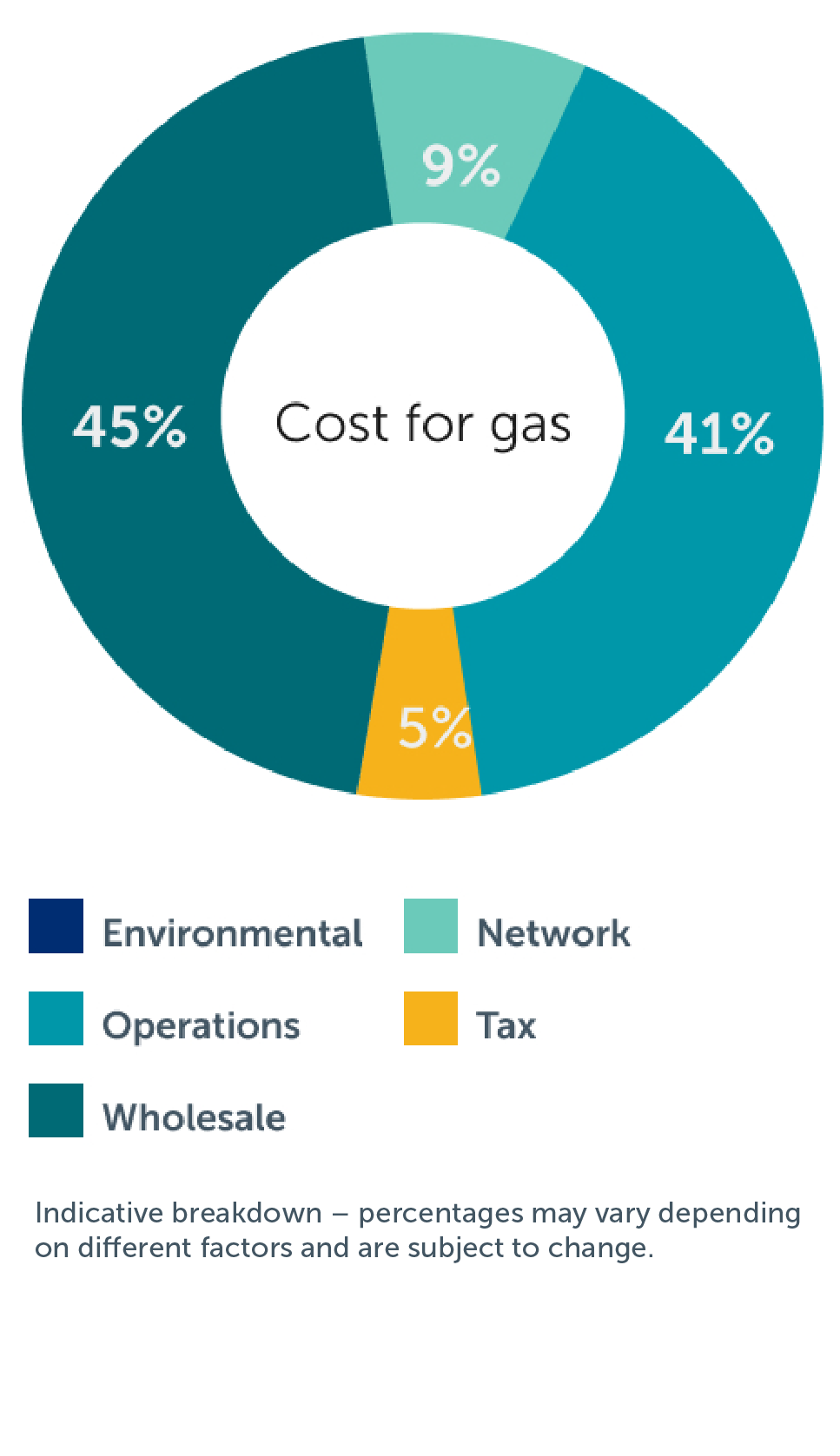Check out our guide below, which breaks down your invoice and explains what each section means. All your energy bills are available to view online via your business energy account.
Electricity invoice page 1

1 - Invoice structure identifier
The 'Customer Account Number' on your old invoice has been replaced with an 'Invoice Structure Identifier' on your new invoice. This is a ten-digit number that will always begin with '87' e.g. 8700000000.
2 - CCL registration number
This is a new addition to your invoices. CCL stands for 'Climate Change Levy.' The CCL is a government tax designed to encourage business customers to use energy more efficiently and support the reduction of the UK's overall emissions.
3 - Electricity supply invoice
Your invoices were previously titled ‘Statement of Account’. We have changed this, so they are now titled ‘Supply Invoice’.
4 - VAT
Depending on how much energy you use and the size of your business, you will either pay standard VAT at 20% or reduced VAT at 5%. Your invoice now clearly displays this. For more on VAT thresholds please see the link and if you struggle to pay view more information about ways to pay.
5 - Site reference
If you are a multi-site business your site reference is used to identify individual properties. In the updated invoice you may notice we’ve added a prefix of ‘AGR’ which stands for ‘Agreement.'
6 - How to pay
If you pay by Bank Transfer, you will be required to make a change in your system to ensure payments are received. If you pay by Direct Debit, you should have received notification of this change already; you do not need to take any action. Your payment collection date will feature here if you pay by Direct debit.
Electricity invoice page 2

7 - Delivery address
This is the supply point where your energy is supplied.
8 - Invoice direction
If the estimated consumption has been adjusted, it will be shown as a ‘reverse’ entry in the tariff and charges table. The amended usage for that period and any new charges will be shown as a ‘forward’ entry in the tariff and charges table.
9 - Converting electricity units to kWh
In this section, you will see the units used, correction factor, adjusted units, calorific value and the total units (kWh) which are needed to convert electricity units used to kWh.
10 - Delivery period
This refers to the start and end dates of your invoice charges. Your new invoice will also show standing charges on a ‘per day’ basis.
11 - Standing charges
This section details any standing charges you may have incurred. These standing charges are a standard part of any energy contract. They're used to cover things like provision of supply, access to the supply grid, ongoing maintenance and upkeep to ensure the quality of supply is continuous.
12 - Quantity
In this section, you will see the energy used in kWh, to one decimal place. ln addition you will also see the total number of days within your delivery period.
13 - Unit rate
The Price Per Unit is now shown to six decimal places and now includes the Feed in Tariff (FiTs). This is the Government tariff designed to help increase the level of renewable energy in the UK. The unit rate you will see on your new invoice will be the combined amount of your old rate plus FiTs.
Invoice summary

14 - Contact us
If you can't find what you need via your online account, this section details the different ways you can contact our team. Please contact here
15 - If you have a complaint
Find out how to make a complaint and help us improve our service to you. You can get in touch via phone, email or post. You can visit our page to find out more.
16 - Citizen advice
Details on how to receive free, impartial information from Citizen's Advice, including how to contact and the process it involves. You can find more helpful information here.
17 - Emergencies
How to contact us if you suspect a gas leak or other gas emergency. Visit our emergencies page
18 - Submit meter readings
In this section, you can find out how to submit your latest meter readings, which will help us provide you with the most accurate invoices. You can submit meter readings via your online account. For more info on meter readings, please view this page
19 - Clarity
You can take control of your energy usage and help boost efficiencies with SSE Clarity. SSE Clarity is a powerful energy management platform that helps you take control of the energy you use. Using data from your smart meter, it brings together a suite of tools to help measure, manage and forecast your energy usage. For more info, visit our dedicated page
20 - Moving premises
Moving In / Out: What to do if you're moving premises. Visit our dedicated page for more information click here
21 - How to pay
Includes the different methods of payment for your invoices. You can find more information here
Electricity cost breakdown

Environmental
Charges to fund environmental initiatives or regulations, such as renewable energy subsidies, carbon reduction programs, or emissions trading schemes.
Network
Charges cover the cost of maintaining and operating the infrastructure to deliver electricity or gas, such as power lines, pipelines, and substations.
Operations
Costs related to the day-to-day operations of providing electricity or gas, including customer service, billing, and administrative expenses.
Tax
Government-imposed taxes such as value-added tax (VAT) are based on energy consumption and the type of business.
Wholesale
The cost associated with purchasing electricity or gas from the wholesale market, where energy is bought in bulk by suppliers before being distributed to consumers.
Third-party intermediary
Fees are paid to intermediaries who facilitate contracts or negotiations between energy suppliers and consumers.
Gas invoice page 1

1 - Invoice structure identifier
The 'Customer Account Number' on your old invoice has been replaced with an 'Invoice Structure Identifier' on your new invoice. This is a ten-digit number that will always begin with '87' e.g. 8700000000.
2 - CCL registration number
This is a new addition to your invoices. CCL stands for 'Climate Change Levy.' The CCL is a government tax designed to encourage business customers to use energy more efficiently and support the reduction of the UK's overall emissions.
3 - Gas supply invoice
Your invoices were previously titled ‘Statement of Account’. We have changed this, so they are now titled ‘Supply Invoice’.
4 - VAT
Depending on how much energy you use and the size of your business, you will either pay standard VAT at 20% or reduced VAT at 5%. Your invoice now clearly displays this. For more on VAT thresholds please see the link and if you struggle to pay view more information about ways to pay.
5 - Site reference
If you are a multi-site business your site reference is used to identify individual properties. In the updated invoice you may notice we’ve added a prefix of ‘AGR’ which stands for ‘Agreement.'
6 - How to pay
If you pay by Bank Transfer, you will be required to make a change in your system to ensure payments are received. If you pay by Direct Debit, you should have received notification of this change already; you do not need to take any action. Your payment collection date will feature here if you pay by Direct debit.
Gas invoice page 2

7 - Delivery address
This is the supply point where your energy is supplied.
8 - Invoice direction
If the estimated consumption has been adjusted, it will be shown as a ‘reverse’ entry in the tariff and charges table. The amended usage for that period and any new charges will be shown as a ‘forward’ entry in the tariff and charges table.
9 - Converting gas units to kWh
In this section, you will see the units used, correction factor, adjusted units, calorific value and the total units (kWh) which are needed to convert gas units used to kWh.
10 - Delivery period
This refers to the start and end dates of your invoice charges. Your new invoice will also show standing charges on a ‘per day’ basis.
11 - Standing charges
This section details any standing charges you may have incurred. These standing charges are a standard part of any energy contract. They're used to cover things like provision of supply, access to the supply grid, ongoing maintenance and upkeep to ensure the quality of supply is continuous.
12 - Quantity
In this section, you will see the energy used in kWh, to one decimal place. ln addition you will also see the total number of days within your delivery period.
13 - Unit rate
The Price Per Unit is now shown to six decimal places and now includes the Feed in Tariff (FiTs). This is the Government tariff designed to help increase the level of renewable energy in the UK. The unit rate you will see on your new invoice will be the combined amount of your old rate plus FiTs.
Invoice summary

14 - Contact us
If you can't find what you need via your online account, this section details the different ways you can contact our team. Please contact here
15 - If you have a complaint
Find out how to make a complaint and help us improve our service to you. You can get in touch via phone, email or post. You can visit our page to find out more.
16 - Citizen advice
Details on how to receive free, impartial information from Citizen's Advice, including how to contact and the process it involves. You can find more helpful information here.
17 - Emergencies
How to contact us if you suspect a gas leak or other gas emergency. Visit our emergencies page
18 - Submit meter readings
In this section, you can find out how to submit your latest meter readings, which will help us provide you with the most accurate invoices. You can submit meter readings via your online account. For more info on meter readings, please view this page
19 - Clarity
You can take control of your energy usage and help boost efficiencies with SSE Clarity. SSE Clarity is a powerful energy management platform that helps you take control of the energy you use. Using data from your smart meter, it brings together a suite of tools to help measure, manage and forecast your energy usage. For more info, visit our dedicated page
20 - Moving premises
Moving In / Out: What to do if you're moving premises. Visit our dedicated page for more information click here
21 - How to pay
Includes the different methods of payment for your invoices. You can find more information here
Gas cost breakdown

Environmental
Charges to fund environmental initiatives or regulations, such as renewable energy subsidies, carbon reduction programs, or emissions trading schemes.
Network
Charges cover the cost of maintaining and operating the infrastructure to deliver electricity or gas, such as power lines, pipelines, and substations.
Operations
Costs related to the day-to-day operations of providing electricity or gas, including customer service, billing, and administrative expenses.
Tax
Government-imposed taxes such as value-added tax (VAT) are based on energy consumption and the type of business.
Wholesale
The cost associated with purchasing electricity or gas from the wholesale market, where energy is bought in bulk by suppliers before being distributed to consumers.
Third-party intermediary
Fees are paid to intermediaries who facilitate contracts or negotiations between energy suppliers and consumers.
